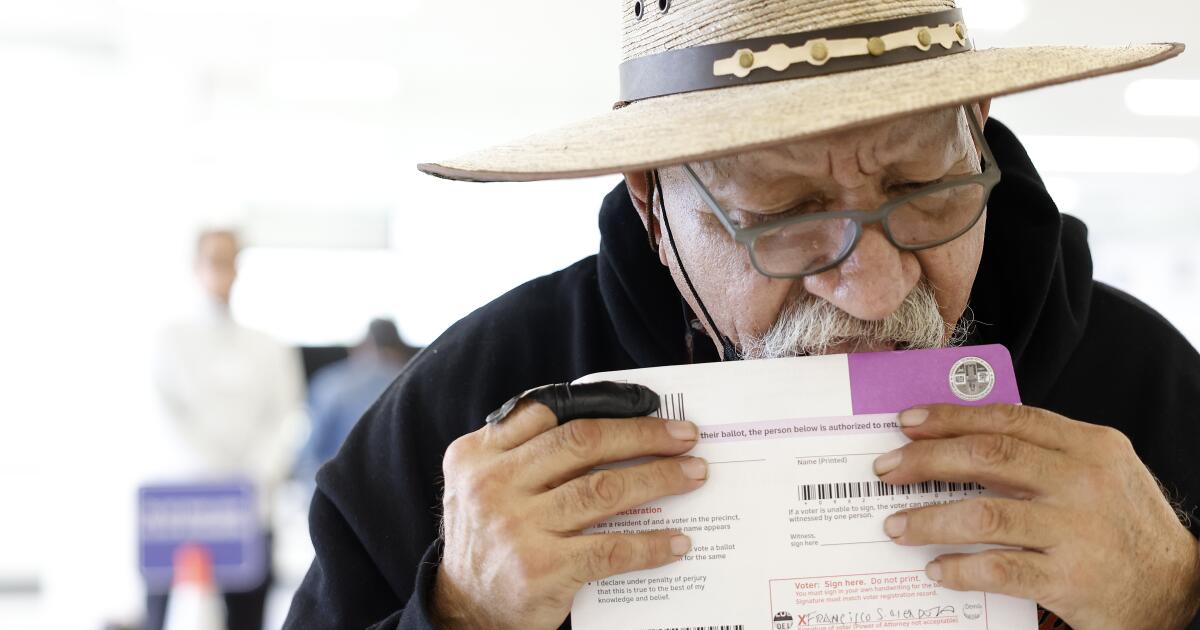Mail-in voting in California sparks false conspiracy theory that elections are rigged

California Secretary of State Shirley Weber pushed back against a torrent of misinformation on social media sites Monday, saying mail-in ballots for the state’s Nov. 4 special election were deliberately designed to reveal how people voted.
Weber, the state’s top elections official, refuted claims by some Republicans and far-right supporters that the holes on ballot envelopes would allow election officials to see how Californians voted on Proposition 50, the redistricting ballot measure that will be decided in a special election in just over three weeks.
“The small holes on the ballot envelopes are an accessibility feature that helps visually impaired voters orient themselves to where they should sign the envelope,” Weber said in a statement released Monday.
Weber said voters can insert their ballots into return envelopes in a way that does not reveal how they voted, or they can vote at early voting locations opening soon or in person on Nov. 4.
Weber’s decision to “set the record straight” was driven by conspiracy theories that have exploded online alleging that mail-in ballots received by 23 million Californians in recent days were deliberately designed to reveal the votes of people opposed to the measure.
“If California voters vote ‘NO’ to Gavin Newscum’s redistricting plan, their response will be shown through a hole in the envelope,” the TikTok Libs posted on social media platform X on Sunday, in a message that has been viewed 4.8 million times. “All Democrats do is cheat.”
Texas Republican Sen. Ted Cruz previously retweeted a similar post that has been viewed more than 840,000 times, and California Republican gubernatorial candidate Steve Hilton, a conservative commentator, called for the November special election to be suspended due to alleged voting irregularities.
The ballot allegation, which was raised by Republicans in previous California elections, stems from holes in mail-in ballot envelopes that were created to help visually impaired voters and allow election workers to ensure ballots were removed from the envelopes.
The special election was called by Gov. Gavin Newsom and other Democrats in an effort to counter President Trump who has urged GOP-led states, including Texas, to redraw their congressional districts before next year’s midterm elections to bolster the GOP’s ranks in the House and bolster its ability to implement his agenda during his final two years in office.
California Democrats responded by proposing a rare mid-decade redrawing of California’s 52 congressional boundaries to increase Democratic representation in Congress. Congressional districts are typically drawn once a decade by an independent state commission created by voters in 2010.
Nearly 600,000 Californians have already returned their mail-in ballots as of Monday evening, according to a vote tracker created by Political Data, an election data company run by Democratic strategist Paul Mitchell, which mapped out proposed congressional boundaries on the November ballot.
California Republican leaders who oppose the ballot measure have expressed concern about election conspiracy theories, fearing the claims could prevent Republicans and others from voting against Proposition 50.
“Please don’t panic people about something that can be easily resolved by returning their ballot,” Roxanne Hoge, chair of the Los Angeles County Republican Party, said on X. “We need every no vote and we need them now.”
Jessica Millan Patterson, a former state GOP chairwoman who leads one of the two main committees opposing Proposition 50, compared not voting early to sitting on the sidelines of a football game until the third quarter.
“I understand why voters would be concerned when they see holes in their envelopes… because your vote is your business. It’s the foundation of our system, being able to [vote by] secret ballot,” she said in an interview. “That being said, the worst thing you can do if you’re unhappy with the way things are going here in California is not vote, and so I will continue to promote early voting and mail-in voting. This has always been a fundamental principle for me.




